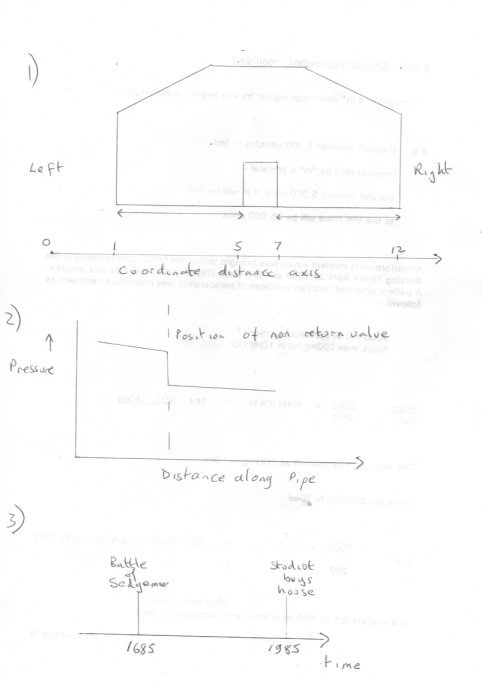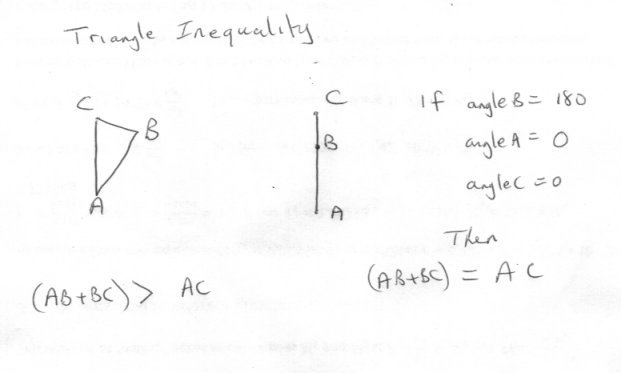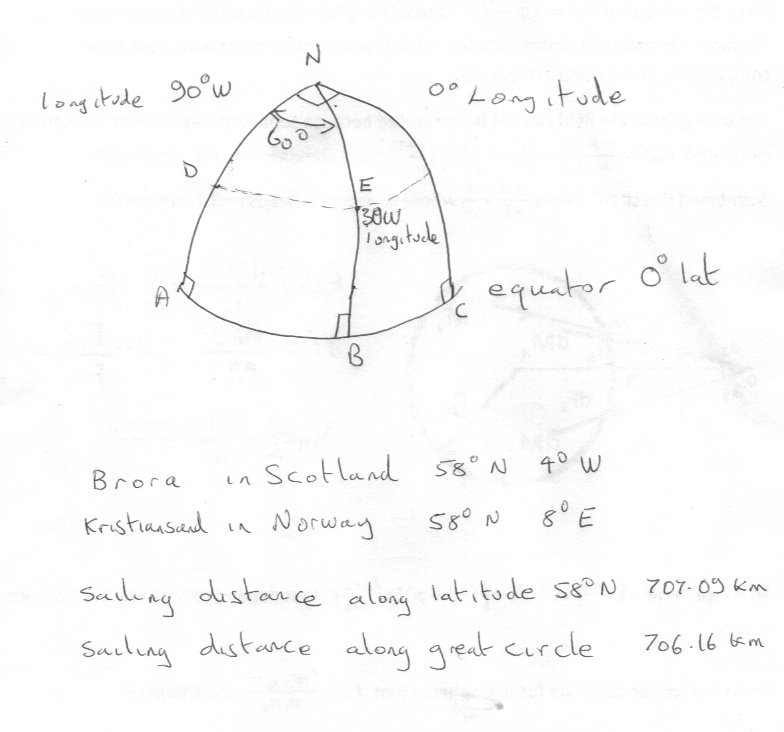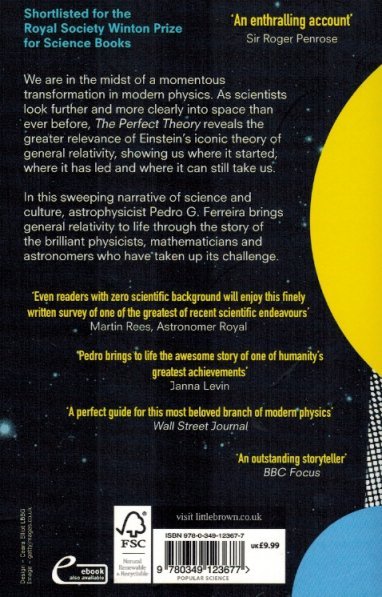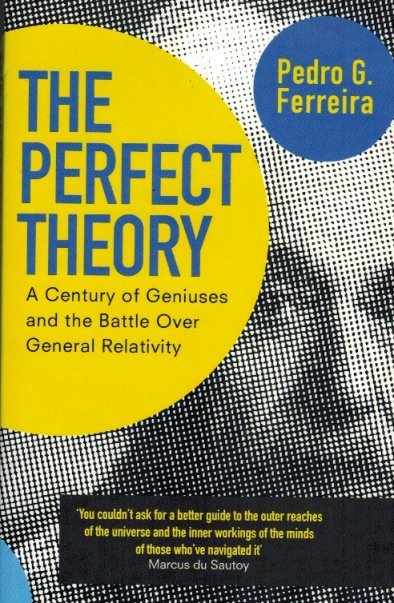-
Posts
18311 -
Joined
-
Last visited
-
Days Won
104
Content Type
Profiles
Forums
Events
Everything posted by studiot
-
Sure thing. It is often said that time is different from distance/length/position because we can proceed in either direction. But let us examine the truth of this proposition with the help of a couple of diagrams. In diagram (1) we have a sketch of my house placed against a distance scale or axis. We can indeed wlak out of the front door and answer the question "How far is it from the corner of my door to the corner of the house" either way Or we can look at the diagram and measure either way on the diagram. Diagram (2) show shows the pressure dropping along a water pipe. I have included a non retern valve partway along to preclude flow in one direction. So water, like time, cannot flow upstream. So here is a realworld example of something, plotted along an axis, that can only flow one way. Yet we can look at the plot and measure in either direction. In diagram (3) we return to time. We can calculate, backwards or forwards, how long it was from the nearby last battle on English soil to when I bought my present house in diagram (1) Of course we cannot travel in time back to either of these events, just as water cannot flow upstream in our pipe. But we can traverse the distance from the front door to the corner of the house. So what is different? Nothing really. All are plots/graphs/diagrams drawn against some definining axes. But, in general, that which is plotted is not necessarily the same as the axes themselves. So when we are using a time axis, we are talking about events, states, positions or other properties plotted against time. We are not directly taking about time itself. So of course, like any other such plot, we can view the entire plot (or at least a section of it) together formeasurement and comparison purposes.
-
I have already proposed studiot's law elsewhere: https://www.scienceforums.net/topic/106314-what-warps-space/?tab=comments#comment-993433
-

Observer effect and Uncertainty principle are the same?
studiot replied to Itoero's topic in Quantum Theory
This thread seems to have stalled, I wonder if this is due to a basic misunderstanding of the Observer effect, perhaps paying too much attentionand too literal attention to a poor Wikipedia article on the subject. So I have stated a new thread for the express purpose of exploring the vagaries of the Observer effect. -
This thread is inspired by confusion in another thread which may be due to a Wikipedia article, I consder misleading and muddled, about the observer effect, https://www.scienceforums.net/topic/116760-observer-effect-and-uncertainty-principle-are-the-same/ although I would say it has relevence to several other current threads as well. https://en.wikipedia.org/wiki/Observer_effect_(physics) Now I think it is good to separate out errors of measurement due to the conditions of observation from the errrors that are inherent in the nature of that which is being observed. But I also think that Wikipedia is wrong to suggest that there are no methods of measurement that are theoretically error free or that quantum effects should be attributed to the observer. Note this thread is about the origin and details of any effects attributable to the observer; It is not about the origin and details of effects due to the measureand, except where the affect the former. Comments invited.
-

Observer effect and Uncertainty principle are the same?
studiot replied to Itoero's topic in Quantum Theory
I have seen no explanation. Sorry if I missed it please point it out. -
Neither the original question, nor any of the 'answers' are compatible with time being a coordinate axis for a physical dimension. The all refer to some function or property being measured or plotted against this axis. As with all such axes, direction is just a convention. It is gratifying that the aussies have the same convention for which way is up that we do. Further I think this is an issue of the philosophy of Science rather than the subject of relativity.
-

Observer effect and Uncertainty principle are the same?
studiot replied to Itoero's topic in Quantum Theory
Start with the triangle inequality. It is the easist to understand. Basically it says that any side of any triangle is shorter than the sum of the other two sides added together. Of course if you are willing to call the second figure a triangle it gives the condition for equality. This seems so obvious it should be trivial but the meaning runs deeper and pops up in suprisingly numerous guises. It is further to go from A to C via B than to go directly. Now imagine AC, AB and BC are vectors. The resultant of two vectors always has smaller magnitude than the sum of the magnitudes of its components, except in the second case, when they are equal. Does this make sense? Please explain to me how your measurement changed the measureand in my example where you sit and wait, doing nothing at all (no measuring) until the light arrives, by which time the event you are measuring is over. -
Ok to make a start on curvature. It's late so I am sorry that the sketch is rather rough. The point is that a sphere is a surface (mathematicians call the solid round object a ball) and is two dimensional. That is we need two numbers to specify any point on it. Conventionally we use latitude and longitude. Both of these are angles. Note that the radius is not needed to specify any point on the 2D surface. The radius takes us into 3D. But a different pair of numbers, representing x and y would give us a plane surface So what is the difference? Geodesics. These are the lines which have the shortest distance between any two points A and B on the surface. In a plane any straight line is a geodesic. Usually the gridlines are geodesics but this is not true of latitude, although it is true of longitude. Geodesics on a sphere are 'great circles' like the equator and lines of longitude. Geodesics also occur in higher dimensions than 2D surfaces, but they are still lines. Why so much emphasis on geodesics? Because they are the path taken by light rays through space and spacetime. Now look at the sketch, showing triangles on the surface of the earth. The 0o and the 90oW lines of longitude, AN and CN intersect at the pole, N, at 90o. The also intersect the equator at 90o, as do all lines of longitude. So the angles of triangle ACN on the surface of the Earth add up to a total of 90o +90o +90o = 270o, rather larger than the 180o for a plane triangle. This is called spherical excess (over 180o) and is dramatically large as the excess depends upon the area of the triangle and ACN is a large triangle. The excess for a smaller triangle, say ABN, can be seen to smaller at 60o. Furthermore if we follow AN to D and BN to E we have a yet smaller triangle, but the apex angle at N is still 60o. So the angles of intersection at D and E must be less than 90o to achieve a smaller spherical excess. So I have set up a real world example, sailing across the North Sea from Brora in Scotland to Kristiansand in Norway, which conveniently happen to be on the same 58th parallel of latitude. From the figures it can be seen that sailing along the parallel is about 1km longer than sailing a true great circle geodesic. Now translating this to the first experimental verification of general relativity (by Sir Arthur Eddington) which is conveniently shown here Light from a star hidden behind the Sun was deflected by the Sun's gravity a minute but measurable amount exactly as calculated by Einstein. There is more discussion of this and possible implications of GR https://www.scienceforums.net/topic/106314-what-warps-space/?tab=comments#comment-993433 https://www.scienceforums.net/topic/114528-gr-and-the-principle-of-reversibility-of-light/
-
I asked you three questions and made two further comments where centuries of evidence with the behaviour of bulk materials directly contradicts specific postulates you have made. None of your smart ass presentation (perhaps aping that of Eddington's prologue in his famous book "Space, Time and Gravitation" ?) answer any of these. Please respond properly as required by the rules here.
-

Equations derived only from E-field & doppler effect
studiot replied to Theoretical's topic in Modern and Theoretical Physics
Maybe you have new equations, maybe you are reinventing the wheel. It's funny how the same subject doesn't appear for ages and then crops up in several places at once. Just like London buses. I have already mentioned to someone else today that you have to be careful when applying relativity via the lorenz factor to electric effects because total charge itself is lorenz invariant, but charge density is not. So the distribution of charge appears different in different frames of reference. This effect arises because charge density or distribution depends upon a measurement of distance in the frame of assessment. And, of course, distance is frame depenendent ie not lorenz invariant. The total charge is the same in all frames because the return current path is often outside the system boundary, perhaps at infinity. -

Equations derived only from E-field & doppler effect
studiot replied to Theoretical's topic in Modern and Theoretical Physics
Well it certainly sounds more like a speculation that mainstream Modern Physics. More to the point it is only a teaser with insufficient detail to comment sensibly. So the ball is in your court to elaborate. -

"Law of middle" (split from De Broglie relation)
studiot replied to yuanxue60616's topic in Speculations
I don't know what that was a response to. But it does not relate to what I offered. -

Observer effect and Uncertainty principle are the same?
studiot replied to Itoero's topic in Quantum Theory
It is more than that it is a strong statement of the circumstances under which you can't measure them, no matter what you do. itoero. It is my belief that the simplest and easiest route to understanding the HUP lies via spectroscopy. Let us say you want to measure the frequency (and therefore the energy) of spontaneous emission of EM radiation from some atom. But this emission takes a finite time. This time to emit appears as a slight blurring or spreading of the emission spectrum. This real (and observable) effect cna be calculated according to the HUP. But since the observer is observing in passive or receiving mode only, he does not / can not affect the emission which comes before he starts observing. -

"Law of middle" (split from De Broglie relation)
studiot replied to yuanxue60616's topic in Speculations
Why? What evidence do you have for this "other" speed? Perhaps (!) there is a language difficulty here. In order to calculate the interval invariant, S, in spacetime it is necessary to scale the time axis by a constant of the appropriate units to convert time units to length units. Then the equation S2 = X2 + Y2 + Z2+(icT)2 makes dimensional sense. c is of course the appropriate constant and is a velocity, as the OP says. -
At that time light was regarded as a wave phenomenon. For all waves, including light, the characteristic speed is independent of the speed of the emitter. The emitter is considered as a point source with its own 'speed'. That is once the wave has been lauched it is entirely controlled by the medium of transmission. An observer, travelling relative to the medium will observe a different velocity. So supersonic aircraft can 'catch up' as you put it with a sound wave. Einstein's innovation was to say that for light, the observed speed is independent of the observer's speed or the same for all observers. That is quite different form every other wave. This discussion is not about a transmission medium for light so don't get diverted into that. Now both of these are local in that the emitter and observer are points and they can only measure the speed near to themselves and in relation to themselves. They cannot measure a 'global' speed that is 'for the galaxy' or wherever. So they must rely on a principle such as Einstein's. No. You can see stationary em waves using lecher lines for instance. https://www.google.co.uk/search?source=hp&ei=Y22GXOLOF4GclwTz4oTQBQ&q=lecher+line+experiment&oq=lecher+lines&gs_l=psy-ab.1.1.0j0i10l2j0i22i30l2.826.2804..4822...0.0..0.214.1498.5j6j1......0....1..gws-wiz.....0..0i131j0i22i10i30.JYtj1z6og1w It was, as I said, formulated to recast Maxwell's equations in a form invariant way. I can write these out if you wish but this is a lot of Maths. Remember that our whole basis of Physics and Astrophysics/Astronomy is that the Laws of Physics are the same in Alpha Centauri as on Earth. That is a global statement that forms the basis of Cosmology, which is about the development and evolution of possible/credible universes. If the laws were not the same then we could not rely on spectroscopy to tell us what the stars are made of and so on. Thank you for your sketch. That's good I can do something today.
-
Given your background and the timescale involved, I would recommend concentrating on the Physics of Relativity, rather than the Maths. The Maths for Special Relativity is accessible to those with high school Maths, Gerneral Relativity is not. So in your essay go into the (Physics) principles of importance in Relativity. 1) The Principle of Relativity, both the pre Einstein version and the updates Einstein introduced. 2) The Principle of invariance of the speed of light to all observers. 3) The principle of equivalence. The first two form the basis of SR adding the third, ugrades to GR. (1) Expresses the desire in Physics to have isotropy and homogenity in space. (ask if you don't know what that means). Another way to put this is the desire to have the laws of Physics look the same to all observers. Well call this ' Form Invariance'. this can be made to work for the Laws of Mechanics (Newton's Laws) but not the Laws of electromagnetism (Maxwell's equations) (2) Is introduced to make Maxwell's equations compatible with Principle (1) (3) The first two are local principles. That is they apply to a small region ( a point) in space. (3) is used to create the Field equations which extends relativity over all space and time. I will post a couple of sketches showing the implications of (3) and the relationship to curvature. Please avoid the 'trampoline analogy'. It is just plain misleading. Is your maths up to knowing that a sphere can be represented by the equation radius = a constant so the position on the surface can be represented by the coordinates [math]\left( {r,\theta ,\varphi } \right)[/math] Where r is the radius, theta and phi are angles?
-

Observer effect and Uncertainty principle are the same?
studiot replied to Itoero's topic in Quantum Theory
It might help to bear in mind that Heisenberg is a special case or subset of a much larger class of inequalities of the format [math]AB \ge \Upsilon [/math] Where [math]\Upsilon [/math] is some constant. In particular the units/dimensions of the constant, upsilon, needs to be consistent with the units of A and B. The use of Planck's constant enables this in Heisenberg. Other constants appear in the Cauchy-Schwarz inequality and the triangle inequality, which are more general examples of the same principle. -
Here is my shortlist of experimental /observational comments on your claims. The gravity vector is observed to have the same sign for both particles and antiparticles. I think it is way more complicated than that. Charge is lorentz invariant. Charge density is not since it involves distance. This would be contrary to measurments in Mass spectrometry. Momentum observations (and calculations) on the dynamics of sub atomic particles. The formation of molecules. You seem to have focused exclusively on atomic physics. The electrons residing outside the nucleus is consistent with our understanding of chemical bonding. DC spark generators emit broad spectrum electromagnetics and were the basis of the original radio comms devices. Electroluminescence is a DC phenomenon. Now you are moving from the straighforward concrete (if wrong) proposition to the fanciful, and sorry but yes preposterous.
-
Perhaps the homework lesson here is that the power requirements cannot be met by home constructible primary cells. That is why, even, commercially, storage batteries are used, preferably rechargeable ones. One alternative might be one (or more) of those new fangled capacitors in the farad range.
-
Lemma, please. Theorem is a bit grand.
-
You need to look at the construction of your battery to reduce its internal resistance. Why is this in homework help?
-
I know this is for an essay, But I think it is legitimate to ask your questions in the main relativity section. Homework help requires you to show your working here, which is not appropriate at your level. So ask (send them a private message) a moderator to move this for you. There are some really good folks here with great knowledge of relativity. I don't know how what your timescale is but this book could have been written for you. My local public library has a copy. Note that Special Relativity is founded on two principles General Relaticvity introduces a third principle and also the Einstein Field Equations. Note the plural - there are 10 of them, usually rolled into one big one that you will not yet have the maths to work. Go well with the writing, and tell us the timescale.
-

Confusion About Energy Density in Electric Field
studiot replied to AP36020's topic in Classical Physics
Not quite. You are mixing up a vacuum and a material dielectric. The volume integral refers to a vacuum (since you have used [math]{\varepsilon _0}[/math] ) There is no polarisation in a vacuum! Remember also that the electric field comes from somewhere. In the case you have described it comes from a parallel plate capacitor. Now conservation of energy tells us that we can either consider the energy due to the separation of charge on the plates. Or we can consider the energy distributed in the field. If you have a material dielectric between the plates then [math]D = {\varepsilon _0}E + P[/math] or you can use susceptibility. -
I haven't proved that but If the GCF = g where g is any integer except 1 then Y = 1 x = g is a solution of the problem.
-
I would start by reading the question and deciding which results are concordant. If you do this correctly you will find a different mean from the one you have pencilled in. (I make that mean 12.13) Show this first.


